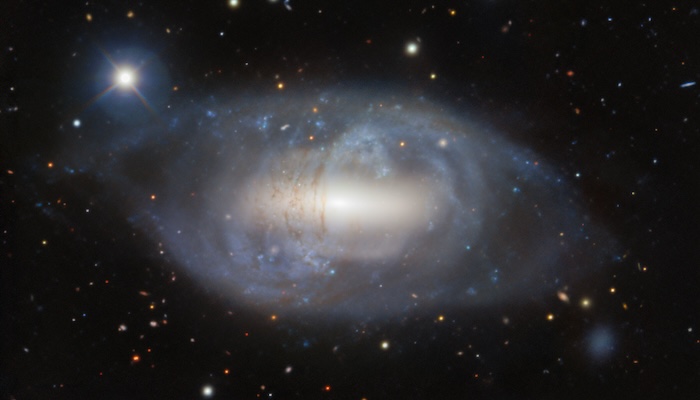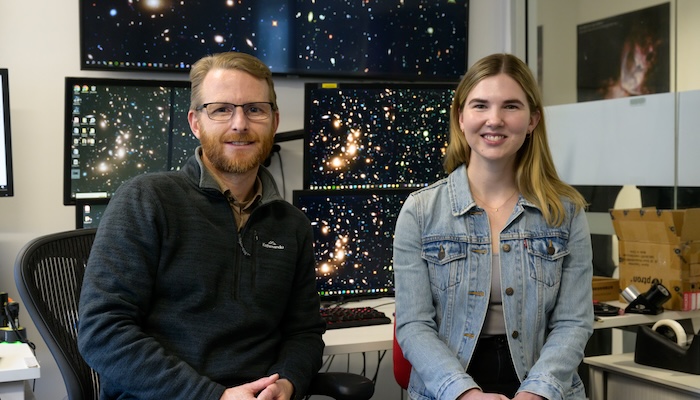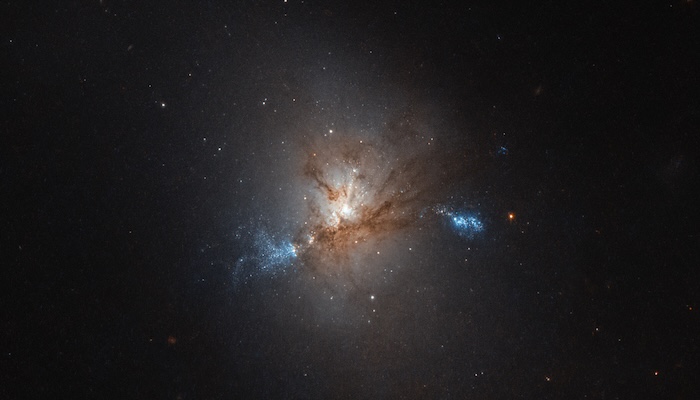An international team of astronomers has discovered massive galaxies stayed remarkably stable over the last four billion years despite turbulent changes in the universe around them.

Fast rotator: This 2024 image of the Helix galaxy NGC 2685, 42 million light years away in the Ursa Major constellation, shows a ring of gas and stars around its middle, evidence of a past merger. Credit: International Gemini Observatory/NOIRLab/NSF/AURA/L. Bassino
The study, published in the journal Monthly Notices of the Royal Astronomical Society, looks back to a period four billion years ago known as the cosmic ‘Middle Ages’. Its finding challenges current theories about how the largest galaxies in the universe evolve.
“We expected these galactic giants to have undergone significant changes since that time,” says lead author Dr Caro Derkenne, an astrophysics PhD graduate from Macquarie University.
“But when we compared the spin of massive galaxies from four billion years ago to similar measurements of massive galaxies in the present-day universe, we found their fundamental properties are surprisingly consistent.”
MAGPI explained
The international team used data from the MAGPI (Middle Ages Galaxy Properties with Integral field spectroscopy) survey to compare similar galaxy types across the two time frames.
“This comparison allowed us to see how galaxies might have changed over the past four billion years,” Dr Derkenne says.
The researchers found that the occurrence of slow rotating galaxies — those with stars moving in more random orbits — is unchanged between the MAGPI sample and present-day galaxies.
“The results from this study are surprising, because the time period from four billion years ago to now is very active in cosmic history,” says senior author Professor Richard McDermid, Director of the Macquarie University Astrophysics and Space Technologies Research Centre.

Exciting times: Professor Richard McDermid (pictured left) and Dr Caro Derkenne (pictured right) are part of an international team of astronomers whose findings challenge current theories about how large galaxies evolve.
“Various theories predict a significant build-up of slow-rotating galaxies during the four billion years since the light left the MAGPI galaxies, driven by frequent collisions and mergers of galaxies that lower their spin.
“However, this first look at the unique MAGPI observations indicates things are much more subtle than expected,” says Professor McDermid.
Capturing four billion-year-old starlight
The MAGPI survey uses the Multi Unit Spectroscopic Explorer (MUSE) instrument on the Very Large Telescope at the European Southern Observatory (ESO) in Chile to obtain detailed information about distant galaxies.
“MUSE is my favourite instrument in the world,” Dr Derkenne says.
“It works like a camera, except it captures not just colour, but detailed light information. For every pixel in an image, it records the intensity of light across a spectrum of wavelengths — like capturing 90 000 individual rainbows from the cosmos.
“We can then analyse the chemical composition and motion of stars, and gas at every location within a galaxy to get a comprehensive 3D view of its structure and dynamics.”
This allows researchers to measure the motions of stars within galaxies billions of light years away.
We’re hitting a point where the simulations are giving us predictions for what happens to galaxies over time and with instruments like MUSE, we’re starting to be able to actually go and check them.
Galaxies can be separated into two main types based on these motions - fast rotators that have most of their stars spinning in an orderly disk, and slow rotators that are more spherical in shape, where stars move in more random directions.
To connect their observations of ancient galaxies to the present day, the team used sophisticated computer simulations from the EAGLE (Evolution and Assembly of GaLaxies and their Environments) project at Durham University in the UK.
“Over billions of years, so many different things can happen to a galaxy, from gaining or losing gas, forming new stars, having supernovae go off or even merging with another galaxy,” says Dr Derkenne.
“We think massive galaxies probably formed as more ordered, rotating disks to begin with, and at some earlier stage in the history of the universe, underwent a change.
“To understand this we need to keep pushing back further to find when that transition happens. We haven’t found it yet.”

Slow spin: The slow rotator galaxy NGC 1222 is 109 million light years from Earth, in the constellation Eridanus, and is seen merging with two other galaxies in this 2016 image from the Hubble telescope. Credit: European Space Agency Hubble Space Telescope and NASA
The study analysed 51 massive galaxies from 36 MAGPI survey fields observed so far. The full survey aims to observe 56 fields, providing an even larger sample to study galaxy evolution in this important cosmic epoch.
- Mathematicians crack a sea ice puzzle, advancing what we know about global warming
- Widespread risk screening could slash dementia cases
“It’s a really exciting time in astronomy,” says Dr Derkenne. “We’re hitting a point where the simulations are giving us predictions for what happens to galaxies over time, and with instruments like MUSE, we’re starting to be able to actually go and check them.
“It's really cool to see where our theories match observations and where they don’t.”
The research is part of a major Australian-led MAGPI survey which was awarded time on the European Southern Observatory (ESO) Very Large Telescope, one of the world’s most advanced optical instruments.
It brings together 23 researchers from 16 institutions across six countries, including Macquarie University and other members of the ARC Centre of Excellence for All Sky Astrophysics in 3 Dimensions (ASTRO 3D).



